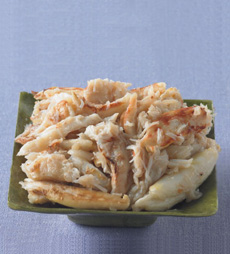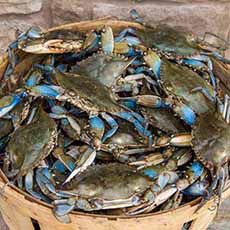RECIPE: Potato and Crab Hash with Poached Eggs, For National Crabmeat Day
|
March 9th is National Crabmeat Day. Some of our favorite ways to enjoy crab: crab cakes, crab dip, Crab Louie (a fancy crab salad), deviled crab, crab soup (bisque, corn-crab soup, she-crab soup) or just plain boiled/steamed crabs or sautéed mixed seafood. Today we offer something different: crab for breakfast. While you can certainly substitute crab for the Canadian bacon in Eggs Benedict, the recipe below starts the day with a hearty hash. Alas, it’s a restaurant-size recipe. Assuming two eggs per portion, it makes 24 servings! However, here’s a slightly different crab hash recipe with family-size proportions. If you like the ingredients below, just substitute them in that recipe. We liked the festiveness of this crab hash recipe from the Idaho Potato Commission: three different types of potatoes, plus the luxury of crabmeat. One tip, though: This recipe uses the most expensive type of crabmeat, jumbo lump. There’s no reason to spend the extra money for home use. Instead, look for crab claw meat or any other variety (the different types of crabmeat). Ingredients 1. PEEL and steam all potatoes until soft. Drain, let cool and cut into medium dice. 2. COMBINE the diced potatoes in a bowl with the onion, peppers, butter, honey, salt, pepper and bread crumbs. Mix thoroughly. Gently fold the crab in and refrigerate. For each order (i.e., it’s a restaurant recipe)… 3. SAUTÉ 6 ounces of loose potato-crab hash in 1 teaspoon of olive oil in a nonstick pan, turning gently until hot and crispy. In a separate pan… 4. POACH 2 eggs. Plate the potato-crab hash and top with the poached eggs. |
|
|
|
CRAB HISTORY The earliest crab fossils date from the Early Jurassic period, ca. 201 million years ago to 174 million years ago. While crabs are found worldwide today, the earliest known fossils come from what is now the area of Britain, which likely represents a stem-group lineage, as it lacks several key morphological features that define modern crabs. The crab population expanded in the Late Jurassic, corresponding with an increase in reef habitats. Crabs increased in diversity through the Cretaceous period (145.5 to 65.5 million years ago). By the end of the period, they were the largest group of decapods, the order of crustaceans that includes many familiar groups, such as crabs, crayfish, lobsters, prawns and shrimp. Crabs are found in all of the world’s oceans. Many species also live in fresh water and on land, particularly in tropical regions. Crabs vary in size from the pea crab, a few millimeters wide, to the Japanese spider crab, with a leg span up to 4 meters (13 feet) [source].
|
||






